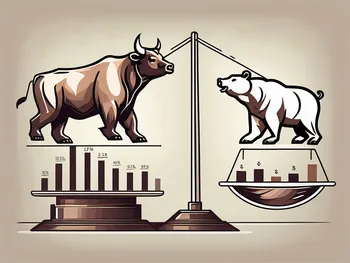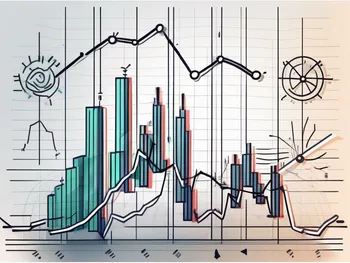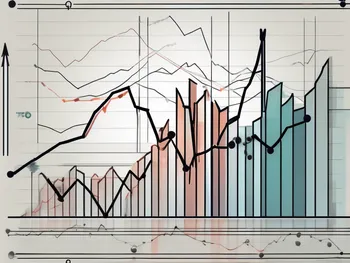What Is a Derivative: A Comprehensive Explanation

As an expert in finance, I am often asked about derivatives – a key component of modern financial markets. Derivatives play a vital role in hedging, speculating, and managing risk. In this comprehensive explanation, I will delve into the basics of derivatives, their types, how they work, their risks and rewards, and their impact on the global economy.
Understanding the Basics of Derivatives
Definition and Overview of Derivatives
Derivatives are financial instruments whose value is derived from an underlying asset, such as stocks, bonds, commodities, or currencies. They enable market participants to speculate on price movements or protect against potential risks.
Let me share a personal story. A few years ago, I was approached by a company looking to expand its operations overseas. They were concerned about potential currency fluctuations, which could impact their profits. I advised them to use currency futures contracts as a hedge to protect their earnings from adverse exchange rate movements. This strategic move proved beneficial, as they were able to stabilize their revenues and mitigate currency risks.
Derivatives, with their ability to provide risk management solutions, have become an integral part of modern financial markets. They offer investors a wide range of tools to manage exposure to various market factors, such as interest rates, foreign exchange rates, and commodity prices. By utilizing derivatives, market participants can tailor their investment strategies to meet their specific needs and risk appetite.
One of the key advantages of derivatives is their ability to enhance market efficiency. By allowing investors to take positions on assets without owning them outright, derivatives facilitate greater market participation and price discovery. This increased liquidity benefits both buyers and sellers, as it enables them to enter and exit positions more easily, ensuring fairer and more accurate pricing.
The Role of Derivatives in Finance
Derivatives are essential for efficient price discovery, risk management, and liquidity in financial markets. They provide investors with opportunities to diversify their portfolios and protect against potential losses.
Moreover, derivative products like options and futures enable speculators to take positions on various assets without owning them outright. This allows for greater market participation and price efficiency.
Derivatives also play a crucial role in facilitating capital allocation and investment. By providing investors with the ability to hedge risks and manage exposures, derivatives contribute to a more stable and resilient financial system. They allow businesses to focus on their core operations while mitigating the impact of market uncertainties.
Furthermore, derivatives have a significant impact on the global economy. They enable businesses to manage currency risks, interest rate fluctuations, and commodity price volatility. This, in turn, promotes international trade and investment by reducing uncertainty and increasing confidence.
In conclusion, derivatives are powerful financial instruments that serve multiple purposes in the modern economy. From risk management to price discovery and market efficiency, they play a crucial role in shaping the dynamics of financial markets and facilitating economic growth.
Types of Derivatives
Derivatives are financial instruments that derive their value from an underlying asset. They are commonly used in various markets to manage risk or speculate on future price movements. Let’s explore some of the most commonly traded types of derivatives.
Futures and Forwards
Futures and forwards are contracts that obligate parties to buy or sell an underlying asset at a specified price and future date. These derivatives play a crucial role in commodities, currencies, and interest rates markets.
In the commodities market, futures and forwards allow producers and consumers to hedge against price fluctuations. For example, a farmer can enter into a futures contract to sell a specific quantity of wheat at a predetermined price, protecting themselves from potential losses if the price of wheat falls.
In the currency market, futures and forwards enable businesses and investors to manage foreign exchange risk. A company that expects to receive payment in a foreign currency can enter into a forward contract to sell that currency at a fixed exchange rate, reducing the uncertainty associated with currency fluctuations.
In the interest rates market, futures and forwards are used to hedge against interest rate movements. Financial institutions can enter into interest rate futures contracts to protect themselves from potential losses caused by fluctuations in interest rates, ensuring stability in their cash flows.
Options
Options provide the purchaser with the right, but not the obligation, to buy or sell an underlying asset at a predetermined price within a specified period. They offer flexibility and can be used for hedging or speculative purposes.
Hedging with options allows market participants to protect themselves against adverse price movements. For example, an airline company that expects to purchase a significant amount of jet fuel in the future can buy call options on oil to establish a maximum purchase price, safeguarding themselves from potential price increases.
On the other hand, options can also be used for speculative purposes. Traders who anticipate significant price movements in an underlying asset can buy options to potentially profit from those movements. This speculative activity adds liquidity to the market and allows investors to express their views on the future direction of prices.
Swaps
Swaps are agreements between two parties to exchange cash flows based on different reference rates or variables. They are commonly used for managing interest rate risk, currency risk, or even commodity price risk. Swaps allow parties to customize their exposures and achieve better risk management.
In the interest rate market, interest rate swaps are widely used by financial institutions to manage their interest rate exposure. For example, a bank that has a portfolio of fixed-rate loans can enter into an interest rate swap to convert its fixed-rate assets into floating-rate assets, reducing the risk of losses if interest rates rise.
Currency swaps are another common type of swap, allowing parties to exchange cash flows in different currencies. Multinational corporations often use currency swaps to hedge their foreign exchange risk when conducting international business transactions.
Commodity swaps enable market participants to manage price risk associated with commodities. For instance, an oil producer can enter into a commodity swap to lock in a fixed price for their future oil production, protecting themselves from potential price declines.
Overall, derivatives play a crucial role in financial markets, providing participants with tools to manage risk, hedge against price fluctuations, and speculate on future movements. By understanding the different types of derivatives available, market participants can make informed decisions and navigate the complexities of the financial world.
How Derivatives Work
The Process of Buying and Selling Derivatives
When buying derivatives like futures or options, market participants enter into contracts with a counterparty or through an exchange. These contracts specify the terms, including the underlying asset, contract size, expiration date, and settlement terms.
As derivatives are typically traded on margin, a smaller upfront investment (initial margin) is required. This magnifies potential returns but also increases risk.
Understanding Underlying Assets
It is crucial to have a solid understanding of the underlying asset when trading derivatives. Factors such as market trends, economic indicators, and geopolitical events can affect the value of the asset and, subsequently, the derivative.
For instance, as an avid investor in agricultural commodities, I closely monitor weather conditions, crop reports, and supply-demand dynamics of the specific assets. This knowledge allows me to make informed decisions when trading agricultural derivatives like futures contracts.
The Risks and Rewards of Derivatives
Potential Benefits of Investing in Derivatives
Derivatives offer several advantages that attract market participants. They allow for enhanced portfolio diversification, potential for higher returns through leverage, and the ability to hedge against adverse market conditions.
For example, during periods of high market volatility, investing in options can enable investors to protect their portfolios by purchasing put options as a form of insurance against potential market declines.
Potential Risks and Downsides
While derivatives present lucrative opportunities, they also come with inherent risks. Excessive leverage can amplify losses, and market participants must carefully manage their risk exposure. Furthermore, derivatives can be complex instruments, requiring a deep understanding of their mechanics to avoid costly mistakes.
I recall an incident from my early days as a derivatives trader, where I failed to consider the impact of unexpected news on the underlying asset’s price. This oversight resulted in significant losses. It was a valuable lesson that taught me the importance of thorough research, risk management, and disciplined trading strategies.
The Impact of Derivatives on the Global Economy
Derivatives and the Financial Crisis
Derivatives have been subject to criticism, particularly in light of past financial crises. The misuse of complex derivatives, such as mortgage-backed securities, contributed to the 2008 global financial crisis. However, it is crucial to recognize that the responsible use of derivatives is essential for efficient markets and risk management.
The Role of Derivatives in Modern Economy
In the modern economy, derivatives play a vital role in hedging risks, boosting liquidity, and facilitating price discovery. They allow businesses to manage currency fluctuations, interest rate exposures, and commodity price risks efficiently. Moreover, they provide investors with a wide array of investment opportunities and avenues for capital growth.
FAQs
1. What are derivatives?
Derivatives are financial instruments whose value is derived from an underlying asset.
2. What are the types of derivatives?
The main types of derivatives include futures, forwards, options, and swaps.
3. How do derivatives work?
Derivatives work by allowing market participants to enter into contracts based on the value of an underlying asset. These contracts can be bought, sold, or used to hedge against potential risks.
4. What are the risks and rewards of derivatives?
Derivatives offer the potential for higher returns and portfolio diversification, but they also come with risks such as leverage and complexity.
5. What is the impact of derivatives on the global economy?
Derivatives play a crucial role in the global economy, facilitating risk management, price discovery, and liquidity.
So, in conclusion, derivatives are powerful financial tools that serve various purposes in modern finance. Whether you are a hedger, speculator, or risk manager, understanding derivatives and their mechanics is essential to make informed investment decisions. Remember to manage risk prudently, stay updated on market trends, and always seek professional advice when venturing into the world of derivatives.
Ready to take your understanding of derivatives to the next level with a platform that’s as innovative as the instruments themselves? Discover Morpher, the revolutionary trading platform that harnesses blockchain technology to offer a unique trading experience with zero fees, infinite liquidity, and the ability to trade a vast array of assets. Whether you’re looking to hedge, speculate, or manage risk, Morpher provides the tools you need, including fractional investing, short selling without interest fees, and up to 10x leverage. Embrace the future of trading with the safety and control of the Morpher Wallet. Sign Up and Get Your Free Sign Up Bonus today, and join the community of traders who are already navigating the markets with precision and ease on Morpher.com.

Disclaimer: All investments involve risk, and the past performance of a security, industry, sector, market, financial product, trading strategy, or individual’s trading does not guarantee future results or returns. Investors are fully responsible for any investment decisions they make. Such decisions should be based solely on an evaluation of their financial circumstances, investment objectives, risk tolerance, and liquidity needs. This post does not constitute investment advice.

Painless trading for everyone
Hundreds of markets all in one place - Apple, Bitcoin, Gold, Watches, NFTs, Sneakers and so much more.

Painless trading for everyone
Hundreds of markets all in one place - Apple, Bitcoin, Gold, Watches, NFTs, Sneakers and so much more.









